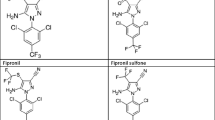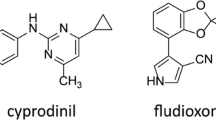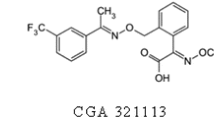Abstract
Fate of fipronil and its major metabolites fipronil sulfide (MB 45950), fipronil-desulfinyl (MB 46513) and fipronil sulfone (MB 46136) were studied in/on grape leaves, berries and soil. As initial residue deposits on the leaves the major component was that of fipronil, while all the 3 metabolites were also present. Among metabolites residues of MB 46513 was highest followed by MB 46136 and MB 45950. In leaves fipronil degraded faster than its metabolites. The residues of fipronil in leaves degraded at the half-life of 9.6 and 18.3 days and that of total fipronil (sum of fipronil and its metabolites) at 13.6 and 20 days, from treatment at recommended and double the recommended dose, respectively. At the time of harvest in leaves, grape berries and soil residues of fipronil and all its metabolites were below the quantifiable limit of 0.01 mg kg−1.



Similar content being viewed by others
References
Casida JE, Hainzl D (1996) Proc Natl Acad Sci USA 93(23):12764–12767
Hoskins WM (1967) Mathematical treatment of loss of pesticide residues. Plant Prot Bull (FAO) 9:163–168
Jadav VR, Wadnerker DW, Jayewar NE (2004) Fipronil 5%: an effective insecticide against sucking pests of chilli (Capsicum annum Linn). Pestology 28:84–87
Pesticide Action Network—UK (PAN) (2000) Active ingredient fact sheet: fipronil. June. Pesticide News London, England 48:20–22
Reddy AV, Srihari G, Kumar AK (2007) Efficacy of certain new insecticides against pest complex of chilli (Capsicum annum L.). Asian J Hortic 2(2):94–95
Sinha SR, Singh R, Sharma RK (2007) Management of insect pests of okra through insecticides and intercropping. Ann Plant Prot Sci 15:321–324
Sule AR, Ambekar JS, Nayakwadi MB (2003) Field efficacy of newer insecticides against onion thrips (Thrips tabaci Lind.). J Maharashtra Agric Univ 33(2):281–282
Tingle CC, Rother JA, Dewhurst CF, Lauer S, King WJ (2003) Fipronil: environmental fate, ecotoxicology, and human health concerns. Rev Environ Contam Toxicol 176:1–66
Acknowledgments
The authors would like to thank Director, IIHR Bangalore and Dr K.K. Sharma, Coordinator, AINP on Pesticide Residues for providing the facilities for carrying out the study, Bayer Crop Sciences Ltd for sponsoring the study.
Author information
Authors and Affiliations
Corresponding author
Rights and permissions
About this article
Cite this article
Mohapatra, S., Deepa, M., Jagdish, G.K. et al. Fate of Fipronil and its Metabolites in/on Grape Leaves, Berries and Soil Under Semi Arid Tropical Climatic Conditions. Bull Environ Contam Toxicol 84, 587–591 (2010). https://doi.org/10.1007/s00128-010-9965-4
Received:
Accepted:
Published:
Issue Date:
DOI: https://doi.org/10.1007/s00128-010-9965-4




